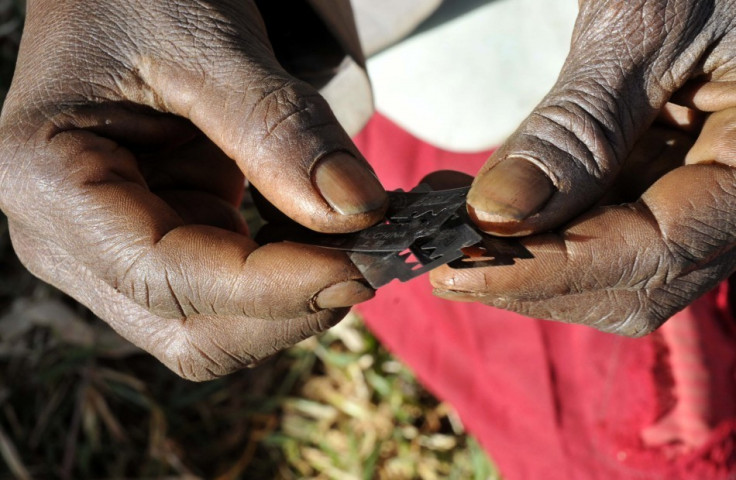FGM: Gynaecologists proposing legalisation of some cutting met with criticism

Gynaecologists have proposed that some forms of female genital mutilation should be legalised and renamed as female genital alteration. The suggestion, put forward by Kavita Shah Arora and Allan J Jacobs, says FGA should be split into four categories with the two least extreme being legally permitted as a compromise.
Category 1 would involve a procedure that has no long-lasting effect on the appearance or function, with an example including a "small nick in the vulvar skin", they wrote in the Journal of Medical Ethics. Category 2 would involve structural changes – but that do not have an "adverse effect on reproduction or on the sexual satisfaction of the woman". An example of this could be the "surgical retraction of the clitoral hood". Categories 3-5 should remain banned, as they impair sexual satisfaction, reproductive function and even death.
FGM is normally carried out on girls aged between five and eight. It is estimated 23,000 girls under the age of 15 could be at risk of FGM in England and Wales. Globally, it is thought two million girls and women have been victims of FGM.
Protection from long-term harm
Arora and Jacobs argue that despite 30 years of efforts to stop FGM, there has been little headway in the practice. They say that instead, intense opposition to FGM could be driving the practice underground, placing girls at greater risk in the long term.
They liken the first two proposed categories to male circumcision, which is largely accepted in western society. They also liken it to vaginal lip sculpting (labiaplasty), which some women pay to have. By rebranding FGM as FGA, the practice would be less demonised and would allow for cultural and religious traditions to be upheld without sacrificing the well-being of girls and young women.
"In order to better protect female children from the long-term harms of Categories 3 and 4 of FGA, we must adopt a more nuanced position that acknowledges that Categories 1 and 2 are different in that they are not associated with long-term medical risks, are culturally sensitive, do not discriminate on the basis of gender and do not violate human rights," they wrote.
"We are not arguing that any procedure on the female genitalia is desirable," they added. "Rather, we only argue that certain procedures ought to be tolerated by liberal societies."

However, their proposal has been met with criticism from peers. A set of commentary pieces, also published in the Journal of Medical Ethics, addresses the failings and concerns implementing such a system involves.
One of the arguments against says that male circumcision should not be accepted either. Brian D Earp, from the Hastings Center, Bioethics Research Institute in New York, wrote: "Many serious problems would be likely to follow from a policy of increased tolerance for female genital mutilation, and that it may therefore be time to consider a less tolerant attitude toward non-therapeutic infant male circumcision. Ultimately, I suggest that children of whatever sex or gender should be free from having healthy parts of their most intimate sexual organs either damaged or removed, before they can understand what is at stake in such an intervention and agree to it themselves."
He said allowing FGA would lead to a host of legal, political and health issues amounting to a "fiasco". Instead, he said the "most promising way forward" is to say that no child should have healthy pars of their sexual organs removed before they can understand what is at stake and before they can agree to it themselves.
Not all cultural traditions deserve respect
Ruth Macklin, of Albert Einstein College of Medicine, New York, also says the comparison of FGM to male circumcision is flawed. She says Arora and Jacobs fail to recognise the symbolic meaning of FGM, in that it is used to control women. Her commentary - Not all cultural traditions deserve respect - says at first look, the argument for legalisation appears persuasive, but under the surface it does not address the wider problem.
She points out when FGM is part of a ceremony, it requires the presence of certain individuals, including those from the prospective groom's family. Furthermore the groom can request to check his future bride is a virgin by inspection of her scars. "It is demeaning, to say the least, to require women to undergo inspection of their genitalia if FGA in whatever form is a cultural requirement for marriage.
"Cultural change proceeds slowly. But with strong support from non-governmental organisations, especially those comprising local and regional women, a cultural tradition designed to control women - even in its least harmful form - is best abandoned."
Finally, Arianne Shavisi from the University of Sussex said this approach is unlikely to fulfil the purpose of FGM – to change the appearance and control a woman's sexual desires. She also points to the problem with comparing FGA with male circumcision and says the ritual aspect needs addressing in both male and female procedures. "Rites of passage are important to all of us, but one must not cause irreversible changes to the body of another person without their consent," she said.
© Copyright IBTimes 2025. All rights reserved.






















